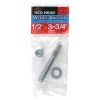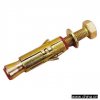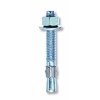Use drop-in concrete anchors. Here is a video of some old guy installing one. Some of his advise sucks, like 'the more you it, the better", etc. but shows you what I'm talking about.
Do as advised get the safe in place, make sure everything is going to work with clearances, etc, mark the holes and outside corners. Move the safe out of the way, use a rotary hammer! Drill deep enough so the anchor is below the surface, this way you can fill the hole when you move. Clean out the holes, drop in the anchors, use the proper setting tool suggested by the manufacturer drive them as specified in the instructions. (Don't listen to the old fool in the video)
Get bolts of the proper size, grade and length, move safe back in place, insert bolts/washers, tighten, done.
When ready to move, just remove the bolts, then the safe. Get some grout and fill the holes.
Much easier than the bolt-type anchors (you don't have to lift the safe over the bolts) and only slightly less strength. The Red Head Multi-Set II RL are some tuff little suckers. Over my career, I have used ten of thousands of these in overhead piping installations that support thousands upon thousands of pounds, every minute of every day for decades upon decades!
Depending on anchor size and concrete strength, they have pull-out strength from 3,000-10,000 lbs each. Paired with the correct grade of bolt and good/heavy/thick washers, the safe won't be going anywhere!
http://www.youtube.com/watch?v=xSM2gsf6X1w&feature=related



